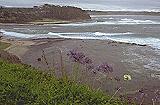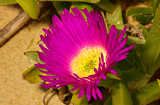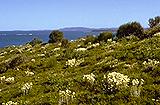|
[Front Page] [Features] [Departments] [SGAP Home Page] [Subscribe]

A Garden and a Puff of Salt Air
|
Trevor Blake
|

|
"HELP!" called Gillian, a New South Wales coastal gardener. It sounded pretty desperate with the howling salt-laden winds covering every surface of the plants with a greasy coating and all the house windows copping it too of course. The burning that becomes apparent a few weeks later is an indicator of the severity of those unforgiving onshore winds.
Plants that the aeons have failed to select in the evolutionary shakeout will shed their leaves or eventually wither and "croak", so for many plants that are planted with the best of design reasons, they are simply not suitable where airborne salt is a problem.
Despair not, there are plenty of things that the good old Aussie gardener can do - plant the whole joint with buffalo grass or kykuyu and put our feet up on the verandah rail and sip another sherry. "Not a good suggestion", did I hear you say? OK, then lets try and grow something a little taller, the ubiquitous Aggie (Agapanthus). Still no deal? - Fussy person! Coprosma or Shiny-leaf - itíll sure do the trick. Can I ask why you bothered moving from that lovely garden in Lane Cove to the salt lashed south coast?
 |
A coastal garden at Ulladulla on the New South Wales south coast. Are there alternatives to the ubiquitous Agapanthus??
Select the thumbnail image or plant name for a higher resolution image (30k).
|
It looks as though we had better delve further into this coastal salt business, but before I do I must relate a little story.
Some years ago a group of us bought a parcel of land adjoining the coast which was lashed from two directions by salt laden winds. We camped on this block, 5 acres of which was natural vegetation and the other 5 was cleared farmland. The farmland, of course was the only place suitable for camping. We experienced and witnessed over the years:
- Tents being literally blown inside out
- Horizontal rain
- Rabbit devastation of anything we planted
- Our nearby neighbours liquid cow poop flowing copiously across the block
- The water-table rising 10cm. above ground level, and
- Our massive plantings disappearing under the most luxuriant growth of phalaris and fog grass.
On our second planting attempt, after the rabbit invasion and a decent fencing of the 5 acres, our dear neighbour (who had begun to take quite an interest in these quaint city folk) leaned on our gate one morning and kindly informed us that the only plants we would be able to would be" Shinyleaves" -hence my eagerness to pass on this gem of information. We overcame these problems and planted 8,500 native plants in our enclosure. Today some 20 years later, we camp in total shelter in a paradise of birds and other wildlife.
If there is a problem of airborne salt then it is very useful to know just how strong that exposure really is. A site that is several streets back has some protection from the full frontal blast that accompanies a churning sea and driving onshore wind. So too, is the site that is in the lee of a headland or behind some screening trees or hedge, even though it is right on the beachfront. Good measures to gauge this exposure are:
- Ascertain whether you are in direct line with the destructive wind that whips up fine spray which drifts like clouds over the coast, or
- Look at your house or car windows, if they are heavily coated with a greasy film directly after a storm then you are probably in what I regard as a front line site
In both cases your selection of plants will be a little restricted until you create some shelter. Once this is achieved the whole scene changes and the choice is much wider. It is interesting to note that rain accompanying these storms can lessen the damage by washing off the salt.
Letís consider this a little further. If, for instance, Eucalyptus species are found right down near the water's edge, these trees would be getting some kind of shelter as I have never known or observed any species of euc. that is able to withstand the 'full frontal' for prolonged periods - even species that originate from coastal areas. Plants in this situation usually show burning of the leaves and eventually die back and finally succumb.
Observe the frontal dune situation for a moment... the species that are close to the sea and growing on this dune are limited, stunted in growth and are often washed by waves or even destroyed by them. Behind this primary dune grow a greater range of plants and their height is significantly increased, particularly in the swales (less salt-air exposure). Headlands are frequently very exposed sites, plants are stunted, dense and form a closed canopy, restricting wind damage and the range of species again is relatively small. Quite often one side of the site is more protected than the other, this then reflects the direction of the damaging winds.
 |
Carpobrotus species ("pigface") are tough, frontline plants of coastal dunes. This is Carpobrotus rossii.
Select the thumbnail image or plant name for a higher resolution image (39k).
|
I have noticed an interesting situation develop on the Victorian south-west coast where a garden, 50 metres from the shore, facing the damaging easterlies on that coast, suddenly becomes fully exposed, due to the removal of a line of giant Monterey Cypress. This line of dense trees, totally out of place in the area, was demolished in one enlightened move, deflecting the salt winds up and over the overlooking gardens. The coastal form of Eucalyptus viminalis which becomes dwarfed, stunted and regularly burnt had grown into much taller handsome trees in the protection and now it will be interesting to see how they fare. The rest of the garden has been able to grow quite a wide range of plants still originating from coastal provenances, however. Some years ago several more of these environmental abominations were removed from a nearby block causing a number of plant deaths as the garden adjusted to the new level of exposure.
 |
Coastal heathland plants are adapted to the constant attack of salt-laden winds.
Select the thumbnail image or plant name for a higher resolution image (47k).
|
Assuming that the salt exposure is of the severest kind and a rich and varied garden is desired, it is now important to observe the local plants and find out the names of the species that are growing in similar situations. Sure, if you have reference books on your area, consult them, or collect a small specimen and ask members of the Australian Plants Society for some help. If you are lucky enough to have an indigenous nursery in the area, consult them. I would regard a nursery that is growing plants from coastal provenances to be of great value as I would feel assured of sound knowledge and plants that originate from areas that experience the sorts of conditions with which you have to contend. The reason I say this is that some species that grow naturally by the coast can also be widespread and may not be as able to withstand the rigors you require of them. There are now a wide range of publications that list species and discuss the coastal situation. Use them, but do not rely on them altogether on the degree of wind borne salt hardiness. I see in one publication a list that includes - Acacia longifolia, Banksia marginata and several species of Eucalyptus - these I regard as highly doubtful frontliners.
 |
Banksia marginata occurs in coastal areas but is also widespread inland. Growing such plants in coastal areas requires a knowledge of the provenance of the particular clone.
Select the thumbnail image or plant name for a higher resolution image (47k).
|
You will no doubt have noted that I have placed the emphasis on indigenous plants. I regard it as essential that the quality of an area is preserved at all costs, this means then that a percentage of local plants should be replanted or, if the area has been totally changed, it is even more critical and some of these too should be of tree stature. One of our aims in creating a native or mixed garden should be to improve the natural balance of the area, thus reaping the benefits of the local wildlife.
Perhaps at this stage a few books could be mentioned, add to the list so we can build up a good reference.
- Coastal Gardening in Australia, Rodger Elliot, Lothian.
- Encyclopaedia of Australian Plants, Vol.1, R. Elliot and D. Jones, Lothian.
- Beach Plants of South-eastern Australia, Carolin and Clarke, Sainty and Associates
- Grow what Where, Australian Plant Study Group, Nelson.
To create a dense hedge for protection will certainly allow most plants to be grown successfully, but if a view is to be preserved as a high priority then looking through trunks is usually more attractive than the broad open vista....debatable of course. This will mean a subsequent reduction in your choice of species. The second line group of plants will be the ones that are universally regarded as airborne salt tolerant with the usual preferences for soil types etc.
A friend in South Australia had a combination of salt exposure and heavy limestone. The combination of shallow calcareous soils and the salt air limited his choice to a dozen or so plants, so he turned it into a grey garden with Atriplex, Rhagodia, Leucophyts, Correa, spinifex and Swainsona - the effect was pretty dramatic.
Trevor Blake is an exhibiting member of the Wildlife Artists' Society and is the illustrator of the "Encyclopaedia of Australian Plants". He has written many articles and is the author of "A Guide to Darwinia and Homoranthus". A member of the Australian Plants Society and the leader of the Banksia Study Group, he is a naturalist, photographer and bushwalker and has travelled extensively throughout Australia as well as leading expeditions to the Himalayas and to Patagonia in South America.

[Front Page] [Features] [Departments] [SGAP Home Page] [Subscribe]
Australian Plants online - March 1999
The Society for Growing Australian Plants
|